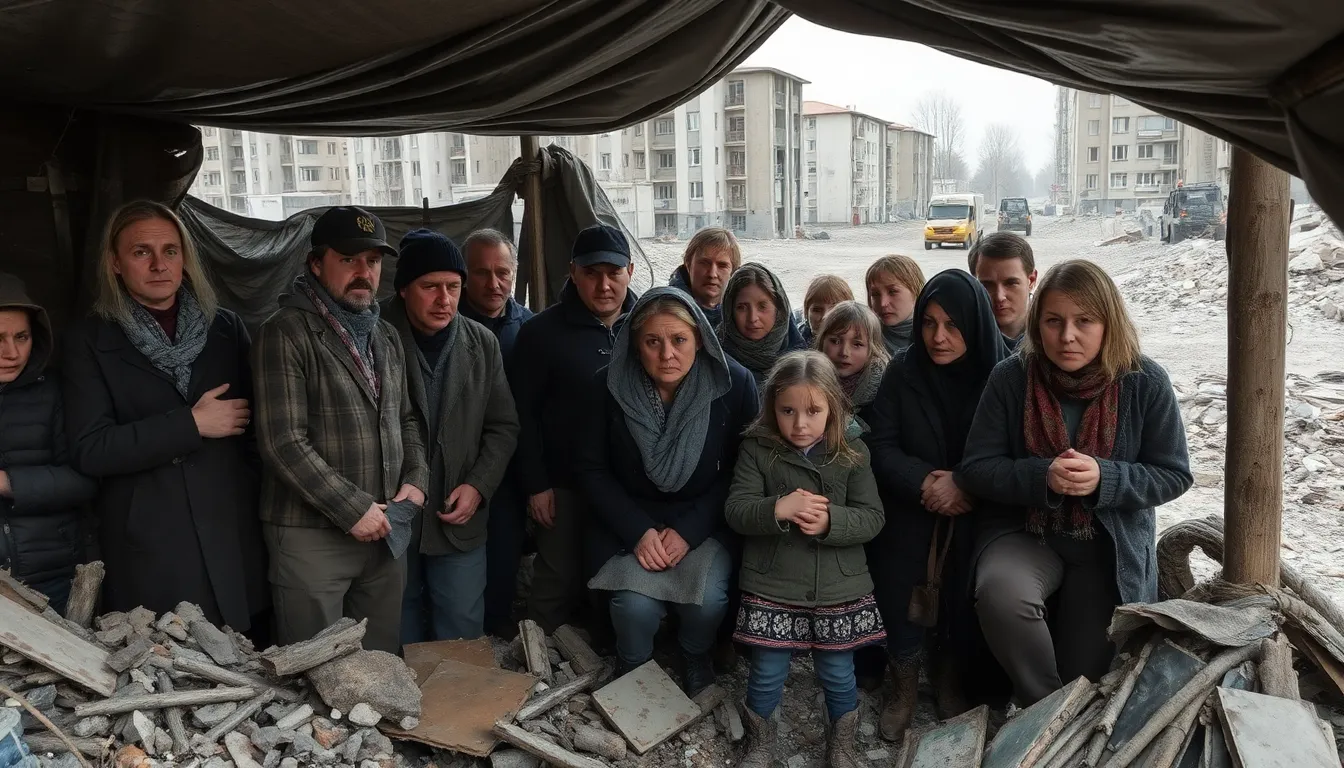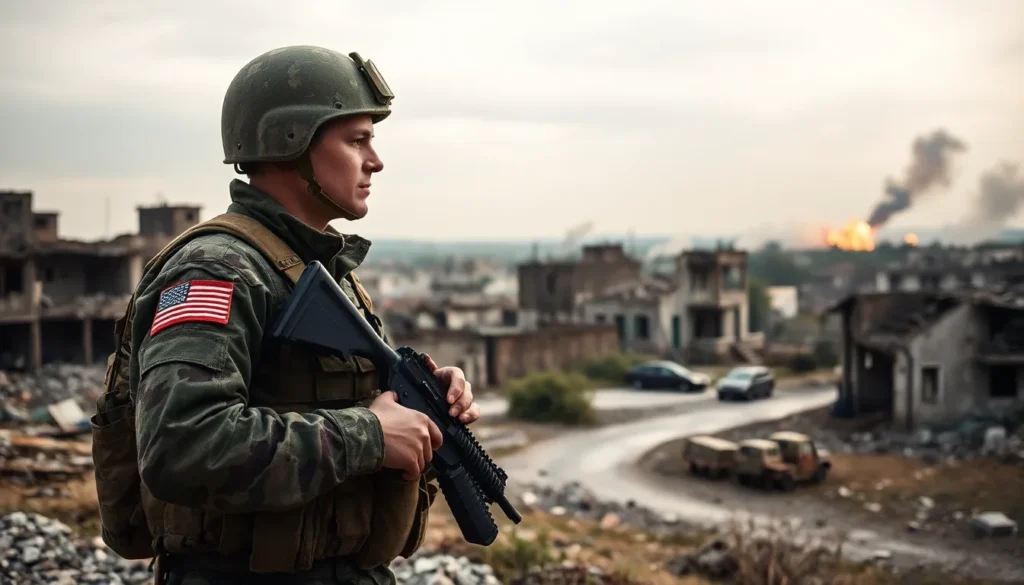Table of Contents
ToggleAs 2025 unfolds, the world finds itself navigating a complex landscape where conflict still reigns in certain corners. While many countries strive for peace and prosperity, others are embroiled in battles that seem to have no end. From skirmishes over territory to ideological clashes, the reasons behind these wars vary widely, but the impact is universally felt.
In this article, we’ll take a closer look at the countries currently at war. Buckle up for a whirlwind tour of global hotspots, where tensions simmer and alliances shift faster than you can say “diplomatic relations.” Understanding these conflicts isn’t just for history buffs; it’s essential for anyone who wants to grasp the ever-changing dynamics of our world. So grab your virtual passport and prepare for a journey through the tumultuous terrain of 2025’s war-torn nations.
Overview of Global Conflicts in 2025
In 2025, various countries experience ongoing conflicts fueled by multiple factors. Territorial disputes drive tensions in regions like Eastern Europe and the South China Sea. Political unrest and authoritarian regimes contribute to instability in countries across Africa and the Middle East. Economic disparities also exacerbate conflicts, as seen in nations struggling under resource scarcity.
Numerous hotspots emerge globally. Ukraine faces continued aggression from Russia, with military confrontations persisting along defined borders. In the Middle East, Syria remains engulfed in a protracted civil war, with various factions vying for control. Ethiopia grapples with internal strife as ethnic tensions lead to widespread violence.
Humanitarian crises unfold in active conflict zones. Millions of displaced individuals rely on international aid to survive. Access to basic services, such as healthcare and education, deteriorates as war zones expand. Regions like Yemen highlight the dire conditions faced by civilians amid raging battles.
Negotiation efforts occur sporadically. Diplomatic talks attempt to address conflicts in Afghanistan and Sudan, though progress remains minimal. International organizations strive to mediate disputes while advocating for peace. Their influence shapes public discourse around the necessity for resolution.
Understanding these global conflicts requires analysis of their multifaceted nature. Social, political, and economic dimensions intertwine, complicating paths toward peace. Global awareness of these issues fosters a greater understanding of the underlying causes and helps build connections among nations. In this context, awareness of current conflicts proves essential for comprehending global relations as they evolve.
Major Conflicts

As of 2025, several nations remain embroiled in significant conflicts. These situations stem from a mix of political, social, and economic issues, emphasizing the need for awareness and understanding.
Ukraine: Background and Current Status
Ukraine faces relentless aggression from Russia, persisting since 2014. The conflict escalated significantly following the annexation of Crimea. In recent months, frontline battles intensified in Eastern Ukraine, particularly around strategic cities. Millions of civilians have been displaced, leading to a dire humanitarian crisis. International support for Ukraine persists, with military and economic aid from numerous countries. Peace talks often stall, complicating the resolution of this ongoing conflict.
Syria: Background and Current Status
Syria’s civil war, ongoing since 2011, remains one of the world’s most devastating conflicts. Various factions, including government forces and opposition groups, continue to clash, prolonging the strife. Foreign intervention from multiple nations adds complexity to the situation. Millions live in humanitarian crises, struggling with access to basic necessities such as food and healthcare. International organizations attempt to provide aid, though access to affected areas remains limited. Recent developments indicate a potential for renewed discussions, yet progress continues to falter.
Ethiopia: Background and Current Status
Ethiopia experiences severe ethnic tensions, causing violent outbreaks between different groups. The conflict, which escalated in the Tigray region, has led to widespread displacement and suffering. Reports reveal significant human rights abuses as various factions clash over power and resources. International pressure aims to mediate the situation and restore stability, yet peace talks have yielded minimal results. As the crisis deepens, many Ethiopians struggle to survive, relying on crucial international assistance. The road to resolution remains fraught with challenges and uncertainties.
Impact on Civilians
Ongoing conflicts in 2025 severely affect civilian populations across war-torn regions. Understanding these effects helps illustrate the dire circumstances faced by those caught in the crossfire.
Humanitarian Crisis
Humanitarian crises escalate within conflict zones. Millions lack access to clean water, food, and medical care. Aid organizations struggle to meet the urgent needs of affected communities. Access remains restricted due to violence and instability, hampering relief efforts. Various agencies continue to advocate for those trapped in these situations, highlighting the necessity for international support and intervention. Persistent fighting hinders peace, preventing effective delivery of assistance. As conflicts drag on, the scale of the crisis deepens, emphasizing the importance of addressing underlying causes.
Displacement and Refugees
Displacement rates soar, affecting millions. Families flee their homes seeking safety, often ending up in overcrowded camps with limited resources. Refugees face numerous challenges, including inadequate shelter and lack of sanitation. Many find themselves in neighboring countries, straining local economies and health systems. International responses vary, with some nations providing temporary asylum while others tighten borders. Amid these hardships, displaced individuals retain hope for a return to normalcy. Long-term solutions remain elusive, keeping the plight of refugees at the forefront of humanitarian concerns.
International Response
International responses to ongoing conflicts reflect a complex web of humanitarian and diplomatic efforts. Various nations and organizations actively engage in peacekeeping missions, humanitarian aid, and diplomatic dialogues to address war’s multifaceted consequences.
Peacekeeping Efforts
Peacekeeping operations remain integral to stabilizing conflict zones. The United Nations and regional organizations deploy forces to monitor ceasefires and protect civilians. Troops from countries like Canada and Brazil are currently on the ground in hotspots. Increased funding for humanitarian missions supports vital infrastructure, including medical facilities. Notably, robust efforts are underway to facilitate the safe return of displaced populations, while enhancing local security measures remains crucial. Activating peacekeeping forces often depends on the consent of involved parties, complicating rapid deployment.
Diplomatic Initiatives
Diplomatic initiatives aim to bring dialogue and negotiation to the forefront. Countries engage in multilateral talks to encourage ceasefires and methodically address root causes. Key platforms, such as the United Nations General Assembly, provide critical venues for discussions. Various nations, such as Norway and Qatar, have facilitated talks in regions like Syria and Afghanistan. Global leaders emphasize the importance of inclusive discussions, pushing for the involvement of all stakeholders. Progress often hinges on the willingness of conflicting parties to compromise, highlighting the urgency of coherent diplomatic strategies.
Future Outlook
Conflicts will likely persist in numerous regions as geopolitical tensions escalate. Disputed territories in Eastern Europe and ongoing friction in the South China Sea could ignite further clashes. Countries like Ukraine remain at the forefront of instability, grappling with the implications of Russian aggression and uncertain diplomatic resolutions.
Syria’s protracted civil war shows no signs of resolution, as various factions vie for power and outside influences complicate peace efforts. High levels of human suffering reflect the dire humanitarian crisis, demanding urgent international attention. Ethiopia’s ethnic strife may worsen, with the potential for additional outbreaks of violence as underlying conflicts remain unaddressed.
Humanitarian crises are expected to create further challenges for affected populations. Millions displaced from their homes will rely heavily on international aid, with shortages of food, medical care, and shelter becoming increasingly common. Strained resources in neighboring countries may lead to heightened tensions and frustration among local communities, responding to the influx of refugees.
Negotiation efforts appear sporadic, with minimal advancements in peace talks concerning Afghanistan and Sudan. International organizations remain committed to mediation, though success largely depends on the willingness of conflicting parties to engage constructively. Multilateral discussions continue to highlight the need for durable resolutions.
Peacekeeping initiatives remain essential for stabilizing war-torn areas. Troops deployed from nations such as Canada and Brazil aim to maintain ceasefires and protect civilians amidst chaos. Increased funding for humanitarian missions supports critical infrastructure needed for recovery and cohesion among divided populations.
Diplomatic strategies require ongoing commitment from global leaders. Platforms like the United Nations General Assembly facilitate necessary dialogues, offering hope for peaceful solutions. Collaborative efforts among nations such as Norway and Qatar emphasize the importance of inclusivity in negotiations, fostering an environment conducive to genuine progress.
The ongoing conflicts of 2025 reveal a world grappling with deep-rooted issues and complex geopolitical tensions. As humanitarian crises unfold millions face displacement and dire living conditions. The need for effective international responses and sustained diplomatic efforts is more crucial than ever.
Understanding these conflicts not only sheds light on the suffering of affected populations but also highlights the importance of global cooperation in seeking resolutions. The path to peace remains challenging yet vital for the stability of nations and the well-being of countless individuals. As the international community navigates these turbulent waters the hope for a more peaceful future hinges on collective action and commitment to dialogue.





